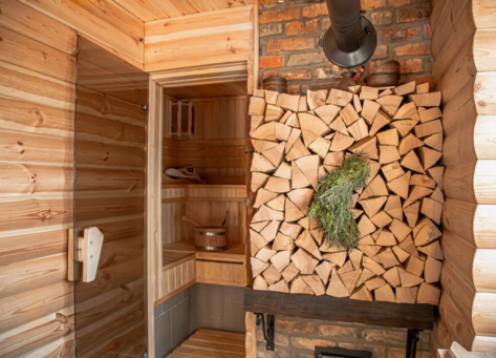Energy Efficiency in Ventilating Wood-Burning Saunas
22 March 2025 by Lukas V.When it comes to enjoying the soothing heat and health benefits of a wood-burning sauna, energy efficiency is key. Proper ventilation and insulation play crucial roles in ensuring that your sauna operates at optimal efficiency while balancing heat retention. By following some simple maintenance tips and implementing the right strategies, you can create a more sustainable and energy-efficient environment for your sauna experience.

Choosing the Right Ventilation System for Your Wood-Burning Sauna
A well-designed ventilation system not only helps maintain a pleasant temperature and humidity level inside the sauna but also plays a key role in maximizing energy efficiency. There are several factors to consider when selecting a ventilation system for your wood-burning sauna. First, it is important to ensure that the system is capable of providing adequate airflow to remove excess heat and smoke from the sauna. This helps prevent the sauna from becoming too hot or smoky, ensuring a more comfortable experience for users. Additionally, the ventilation system should be designed to efficiently remove moisture from the sauna. Excess moisture can not only make the sauna feel stuffy and uncomfortable but can also promote mold and mildew growth, leading to potential health risks and damage to the sauna's interior. Another important consideration when choosing a ventilation system for a wood-burning sauna is the system's energy efficiency. Look for a system that is designed to minimize heat loss while still providing adequate ventilation. This will help keep energy costs low and ensure that the sauna remains comfortable and enjoyable to use. In conclusion, selecting the right ventilation system is essential for creating an energy-efficient and comfortable wood-burning sauna. By choosing a system that provides adequate airflow, efficiently removes moisture, and maximizes energy efficiency, you can enjoy the benefits of a well-ventilated sauna that is both comfortable and cost-effective to operate.Insulating Strategies to Improve Energy Efficiency in Wood-Burning Saunas
Poor insulation can result in heat loss, which not only wastes energy but also prolongs the time it takes to reach optimal sauna temperatures. One effective insulating strategy is to use high-quality insulation materials such as mineral wool or fiberglass batts. These materials have high thermal resistance, which helps to prevent heat loss and maintain a consistent temperature within the sauna. Additionally, using insulation boards or reflective foil barriers can further enhance the insulation properties of the sauna. Another key aspect of insulating a wood-burning sauna is to seal any gaps or cracks in the walls, floor, and ceiling. Even small openings can lead to significant heat loss, so it is important to thoroughly inspect the sauna for any potential air leaks and seal them with caulking or weatherstripping. Furthermore, installing a vapor barrier can help prevent moisture buildup within the sauna, which can compromise the effectiveness of the insulation. A vapor barrier should be placed on the warm side of the insulation to prevent moisture from seeping through and causing damage. By implementing these insulating strategies, you can significantly improve the energy efficiency of your wood-burning sauna, allowing you to enjoy a comfortable and relaxing sauna experience while also reducing your energy consumption.Balancing Heat Retention and Ventilation in Wood-Burning Saunas
The heat generated by the wood stove must be retained within the sauna to ensure optimal temperature levels, while proper ventilation is necessary to remove excess moisture and maintain air quality. One way to balance heat retention and ventilation is to install adjustable air vents in the sauna. These vents can be opened and closed to regulate the flow of fresh air into the sauna and allow for proper ventilation. Additionally, installing a chimney or flue system can help to draw excess heat and smoke out of the sauna while still retaining enough warmth for a comfortable sauna experience. Another key factor in balancing heat retention and ventilation is the insulation of the sauna walls and ceiling. Proper insulation can help to trap heat inside the sauna, reducing energy consumption and ensuring a consistent temperature. Insulating materials such as fiberglass or mineral wool can be used to improve the energy efficiency of the sauna and maintain a comfortable environment for users. Overall, balancing heat retention and ventilation is essential for maximizing energy efficiency in wood-burning saunas. By implementing proper ventilation systems, adjusting air vents, and ensuring adequate insulation, sauna owners can enjoy a more sustainable and cost-effective sauna experience.Maintenance Tips to Ensure Energy Efficiency in Ventilating Wood-Burning Saunas
Maintaining your wood-burning sauna is key to ensuring energy efficiency. By following these maintenance tips, you can keep your sauna running smoothly and effectively:Regularly clean and inspect the chimney to prevent blockages and ensure proper ventilation. A blocked chimney can cause smoke to back up into the sauna, reducing its efficiency.
Check the seals on the door and windows regularly to make sure they are in good condition. Replace any damaged seals to prevent heat loss and improve energy efficiency.
Clean the stove and stovepipe regularly to remove ash and creosote buildup. A clean stove will burn more efficiently and produce more heat with less wood.
Monitor the temperature inside the sauna and adjust the air intake as needed to maintain a comfortable heat level. Burning too hot wastes energy, while burning too cool can lead to inefficient combustion.
Inspect the sauna walls and ceiling for any cracks or gaps that may be allowing heat to escape. Seal any leaks with heat-resistant caulking to improve insulation and energy efficiency. By following these maintenance tips, you can ensure that your wood-burning sauna remains energy efficient and provides a comfortable and relaxing environment for years to come.